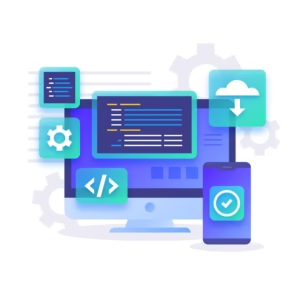 The digital world demands applications that are fast, attractive, and performance-based; hence, Flutter cross-platform app development has now become a preferred choice for all startups and enterprises. This guide is a complete walk-through of everything you should know about Flutter-its features, its advantages, its development process, cost breakdown, and possible future trends.
The digital world demands applications that are fast, attractive, and performance-based; hence, Flutter cross-platform app development has now become a preferred choice for all startups and enterprises. This guide is a complete walk-through of everything you should know about Flutter-its features, its advantages, its development process, cost breakdown, and possible future trends.
What is Flutter Cross Platform App Development?
Definition and Concept
Flutter is an open-source UI toolkit created by Google for developers to build natively compiled applications for mobile, web, and desktop from a single code base. It uses the Dart programming language and has an exceptionally well-stocked library of preinstalled widgets to help build responsive UI easily.
Cross platform development means to provide app development that would work on multiple platforms, mainly Android and iOS, without rewriting the code for each platform. Translation: write once, deploy everywhere.
Evolution of Flutter
Flutter was introduced in 2017 and officially released in 2018. It has grown in uptake quickly and has undergone regular updates since then:
Flutter 1.0 - a stable release in the year 2018
Flutter 2.0 - introduces web and desktop support in 2021
Flutter 3.0 - supports macOS, Linux, and Windows apps from 2022 to 2023
By 2025, Flutter will become a mature, robust, and popular cross-platform development framework with thousands of successful applications out there across diverse domains.
Benefits of Using Flutter for Cross Platform Development
Single Codebase for Multiple Platforms
Through Flutter, developers write a single codebase that runs on Android, iOS, Windows, macOS, Linux, and the web, thus drastically reducing development time and effort, hence guaranteeing a speedier time to market.
Faster Development and Time to Market
Real-time changes on the code without restarting the app provide the highest speed for improvements and shared antics between designers and developers, thanks to the hot reload option.
Beautiful, Customizable Widgets
Flutter includes a comprehensive set of customizable widgets following Material Design and Cupertino standards for attractive UI and native appearance on both platforms.Cost-Effective Development
With less cost since there is no need for teams separate from Android and iOS, Flutter brings down the cost of development. By using less, you get more output—what every startup and SME requires.
Strong Community and Google Support
Regular updates, security patches, and a plethora of resources and plugins for advanced app functionalities are provided due to the strong backing of Google along with a powerful community of developers.
Flutter vs Other Cross Platform Frameworks
Performance Comparison
Due to the ARM or machine code compilation, Flutter performance is on par with native applications. Unlike React Native or Xamarin, it does not use a JavaScript bridge, resulting in harsher animations and slow load times.
Developer Productivity
With hot reload, plenty of pre-built widgets, and great documentation, Flutter let developers iterate fast and hence develop applications with great efficiency.
Platform-Specific Features
Flutter thoroughly supports platform-specific APIs so you could use platform channels to access device features such as GPS, camera, Bluetooth, and so on.
Community & Ecosystem
Flutter is one of the fastest-growing communities in terms of the number of open-source packages and plug-ins. It has Google backing along with support from platforms such as Firebase.
Use Cases and Suitability
- Flutter: Best for rapid development, beautiful UIs, and MVPs
- React Native: A good choice for applications that perform complex native integration
- Xamarin: A good framework for Microsoft-centric ecosystems
- Ionic: The best place to develop simple web-based applications.
Explore the Top 5 Flutter Cross Platform App Development Companies in 2025
1. InfimintusTech
Head Office: Indore, Madhya Pradesh, India Website: www.infimintustech.com
Overview:
InfimintusTech is one of the rapidly developing IT companies, which is known for providing excellent services in Flutter Cross Platform App Development. With a user-first approach and immense expertise in Flutter, InfimintusTech offers powerful mobile solutions running smoothly across platforms.
Flutter Development Capabilities:
- Full cycle Flutter application development from UI/UX right through to backend.
- Integration with Firebase, REST APIs, and GraphQL.
- Deployment in apps store Google Play and Apple App.
- Scalable architecture with custom admin panels.
- Real time features like push notifications and chat systems.
Industries Served:
Healthcare, E-commerce, Education, Logistics, Travel.
Why Choose InfimintusTech:
- Affordable options for new ventures and SMEs.
- An independent pool of flutter developers and project managers.
- Translucent methodology and communication.
- The service is provided even after the launch.
2. Amazon Web Services (AWS)
Head Office: Seattle, Washington, USA Website: aws.amazon.com
Summary:
AWS, being primarily a cloud service, collaborates with premier development firms to provide the services they have for Flutter Cross Platform App Development through AWS Amplify and backend services. This fits the need for a huge app for heavy-duty setups.
3. Microsoft Azure
Headquarters: Redmond, Washington, USA Website: azure.microsoft.com
Summary:
There is really no other ecosystem that is as accommodating as that of Azure to multi-platform development through several possible integrations: App Center, DevOps, and backend services, all of which make it a premier choice for the enterprise Flutter application.
4. Google Cloud Platform (GCP)
Headquarters: Mountain View, California, USA Website: cloud.google.com
Summary:
Being the architect of Flutter, Google has the most native and seamless access to Flutter Cross Platform App Development. The combination of Firebase, Dart, and GCP context makes it optimal for this purpose.
5. IBM Cloud
Headquarters: Armonk, New York, USA Website: www.ibm.com/cloud
Summary:
IBM Cloud backs up the backends of Flutter apps, boasting AI-powered APIs, containers, and high-end scalability for organizations intending to adopt value-added features, such as natural language processing or IoT, in their applications.
Use Cases of Flutter in Real-World Applications
E-commerce Apps
Flutter is the raison d'être for e-commerce platforms with fast performance and customizable UI such as Alibaba with smooth transitions and a feel-good user experience.
Banking & Finance
Fintech applications such as Nubank have opted for Flutter for the building of secure, scalable, and visually compelling applications.
Education Platforms
With the boom in ed-tech, platforms like Google Classroom and Byju's utilize Flutter to offer seamless learning experiences across multiple platforms.
Healthcare & Wellness
Telehealth apps, fitness trackers, and meditation apps leverage Flutter for cross-device adaptability and native-like performance.
Social Media & Chat Apps
Reflectly journaling app is built using Flutter for highly interactive UI with animations and state management.
Flutter App Development Process Step-by-Step
Requirement Gathering & Planning
This phase involves understanding the client vision, goals, and target audience. Based on this, we would create a roadmap, define deliverables, and set timelines.
UI/UX Designing in Flutter
Using Flutter widget tree, wireframes and high-fidelity prototypes are created that resonate well with your brand identity.
Development using Dart
Front-end and back-end development are done using Dart, the native programming language of Flutter, for cross-platform compatibility and better performance.
Testing and Debugging
We perform unit testing, integrations, and testing on actual devices so as to confirm that the application works flawlessly on all platforms.
Deployment to Play Store and App Store
We take care of everything from app store optimization(ASO) to the live launch in Google Play and Apple App Store.
Post-Launch Maintenance
Typically faced issues in Flutter App Development and how to address them challenges.
Handling Native Features
We utilize Platforms Channels to integrate platform-specific functionalities smoothly, such as ARKit (iOS) or Google Maps (Android).
App Size Optimization
We use various app-size-reducing tools like tree shaking and asset compression, maintaining performance levels.
State Management Complexity
Depending on the complexity of the app, we use appropriate state management solutions like Provider, Riverpod, or Bloc.
Device Compatibility Issues
We use adaptive widgets and thorough testing to ensure that the app works on all devices, including all screen sizes and OS versions.
Hiring a Flutter App Development Company
What to Look For in a Flutter Development Agency
- Proven Flutter portfolio
- Client testimonials
- Custom approach to development
- Transparent pricing and proces
In-House vs Outsourcing Flutter Development
Outsourcing to a specialized Flutter agency gives the advantages of working with experienced developers, low rates, and short timelines.
Questions to Ask Before Hiring
- Do you have Flutter case studies?
- What is your development process?
- How do you maintain the application?
- May I get your UI/UX support?
Flutter App Development Cost in 2025
Key Factors Influencing Cost
- App complexity and features
- Third-party integrations
- Custom animation and UI
- Backend development needs
Cost Breakdown
- Design: 15-20%
- Development: 50-60%
- Testing & QA: 10-15%
- Deployment & Support: 10-15%
Average Market Rates
Basic Flutter apps range from $5,000 to $15,000, while complex apps may go as high as $50,000 or more depending on features and timeline.
Future of Flutter & Cross Platform Development
Upcoming Features in Flutter
- Better desktop support
- More 3D rendering
- Integration of AI/ML toolkit
Integration with AI, ML, and IoT
Flutter is branching out to machine learning, IoT apps, and wearable devices, making it future-ready.Why Flutter is Future-Proof
Flutter as a sustainable and flexible option for long-term app development is being backed by Google, with an active community, and open-source.
Why Choose Us for Flutter Cross Platform App Development
Our Experience with Flutter
We have built and launched dozens of successful Flutter apps for clients in healthcare, fintech, retail, and so on.
Portfolio of Cross Platform Apps
Our portfolio features apps with millions of downloads, with 4.5+ star ratings on app stores.
Custom Solutions & Agile Methodology
From MVP to enterprise solutions, we customize all projects according to Agile methodology, so solutions come fast and efficient.
End-to-End Development Support
We will be with you through every step of your app lifecycle, from UI/UX design down to post-launch maintenance.
Client Testimonials and Case Studies
Our successful clients worldwide speak to our expertise, commitment, and professionalism.
Conclusion
To conclude, Flutter, along with performance, flexibility, and developer friendliness, is creating a revolution in cross-platform app development. One can be an aspiring startup creating its MVP or a large enterprise working towards its mobile presence. In either case, Flutter guarantees a sweet spot for cost, speed, and quality.
Begin-India is providing us the opportunity to share with you an outstanding Flutter development. Start your cross-platform app that leaves a mark in the future digital landscape of 2025 with us. Call us today for a free consultation!













